Overflow for washing: classification, principle of operation
The usual siphon (also known as a water seal) can be found on each and every kitchen, its design provides reliable protection against sewage odors in the room. Overflow is a simple addition to the classical construction, which will allow to discharge excess water into the sewage system without the risk of flooding the kitchen.

Siphon classification
If design features are used as the main classification criterion, then it is possible to select such types of siphons as:
- corrugated - can be considered the easiest option. It is made by hand from the usual sewer corrugations - the flexible tube is simply bent in the form of the letter S and fixed with plastic clamps. Of course, the durability of this design leaves much to be desired;
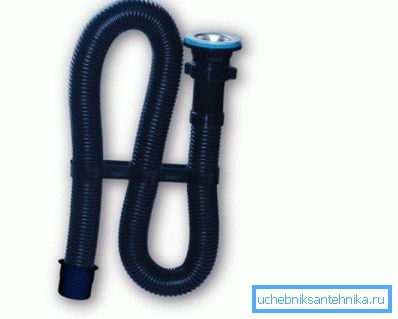
- bottle seal - This design is collapsible, outwardly vaguely resembles a bottle. Inside, the partition is divided into 2 zones, due to which a water blockage is created, which prevents unpleasant odors from the sewage system into the room;

Note! Such designs are easy to disassemble for cleaning, it distinguishes them from other models of hydraulic locks.
- siphon from ordinary metal pipe - the shape is the same, only the tube is used, not flexible, but steel. Bought such devices already in finished form, the kit includes everything you need to install;
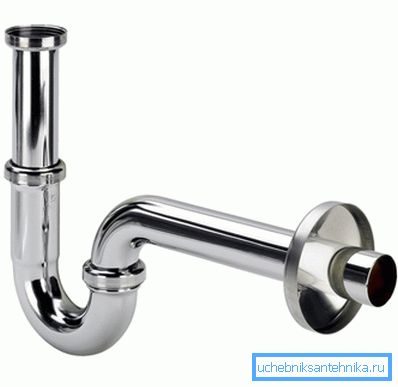
The classification can also be given in the form, for example, if a round siphon does not fit on the sink, then you can always use a compact flat analog. You can also lead the division into groups and the material used - there are devices made of brass, plastic (polyethylene and propylene), cast iron and bronze.
It comes to the fact that some manufacturers automate the work of such a simple device as a water seal. That is, in the normal state, the drain is closed, and it opens when the button is pressed. Unlike conventional siphons, this allows you to drain the water without even wetting your hands.
Recently, such a type of device as a kitchen sink with overflow has become popular. All the difference from conventional models is the presence of an additional drain hole located at the top of the sink.
Read more about the device and the installation of a siphon with overflow
If there is no dishwasher in the house, then ruthless housewives often just wash up the water in the sink and wash dishes in it to wash the dishes. You can, of course, wash it under running water, but then the water bills at the end of the month will “pleasantly” surprise. A hydraulic lock with a double drain is simply necessary in such cases.
Double drain principle
Installing a siphon with overflow to the sink can be called highly desirable, if not necessary. The presence of an additional drain hole at the upper edge of the sink simply will not allow it to overflow, so if a person is distracted and forgot about the fact that he left to collect water in the sink, nothing terrible will happen.
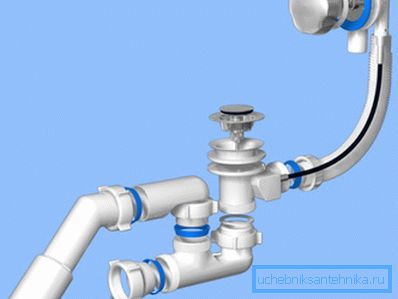
When using a conventional siphon, connecting a sink to a sewer looks like this:
- from the sink through the drain grate water enters the pipe and already through it - into the hydraulic lock itself;
- Considering the lack of free space under the sink, most often the water seal is connected to the sewage system with the help of flexible sewer corrugations.
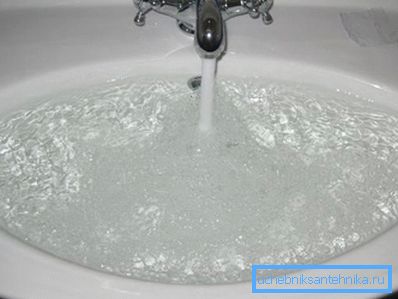
If a drain is used for washing with overflow, then another section of the drain pipe is added to the described construction - an additional drain hole is placed at the upper edge of the sink (usually under the mixer - there it looks appropriate). An additional drain pipe joins the main one directly under the sink (that is, under the main drain).
If the main drain is broken, and the owner simply forgot about the water turned on, then upon reaching the level of the second drain hole, the water will simply be redirected to the sewer. In the absence of a second drainage flood in this situation is guaranteed.
How to install water trap with overflow
Drain with overflow for kitchen sink install no more difficult than the usual water seal. Only steps are added to arrange the hole in the sink and install an additional drain pipe. The main difficulty lies in the fact that most often the sink is installed almost flush with the wall, so getting to the back wall for drilling the hole and installing an additional drain is quite difficult.
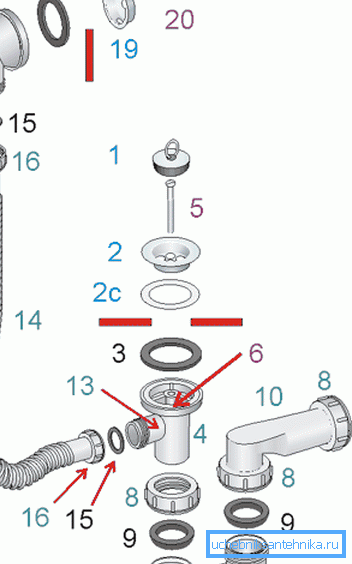
For the convenience of the work, it is more convenient to remove the sink and drill a hole of the required diameter in it. Sinks from a stainless steel need to be drilled accurately, without strong pressure.
You can put a wooden bar under the metal. As for which siphon with overflow to choose, then you can advise you to dwell on a bottle-type device. The price of simple models does not even reach 1000 rubles, so it’s easy to choose the right option.
After the hole is ready, you can install a drain grid and fix the drain pipe with a long bolt that is included in the kit. In this case, the sealing gaskets are placed outside (at the point of contact of the drain pipe with the sink), as well as inside the sink, directly under the metal grate.

After the additional drain pipe is installed, you can proceed directly to the siphon assembly and connecting the sink to the sewer.
Instructions for the execution of work will be as follows:
- First, the siphon body itself is assembled - the lower part is attached to the upper normal thread, and a rubber gasket is used for sealing. It is put on the upper part of the body, slides to the base of the thread, and then the lower part is simply wound. It is allowed to use sealant, but in this case it will be difficult to disassemble the siphon for cleaning;
- after the assembly of the siphon for washing with overflow is completed, a pipe is connected to it connecting it to the sewage system. The usual sewer corrugation is used, and the connection to the outlet from the siphon is made using a conventional plastic cap nut. First, the nut is put on the corrugation, then the sealing ring and the nut are screwed tightly to the outlet;
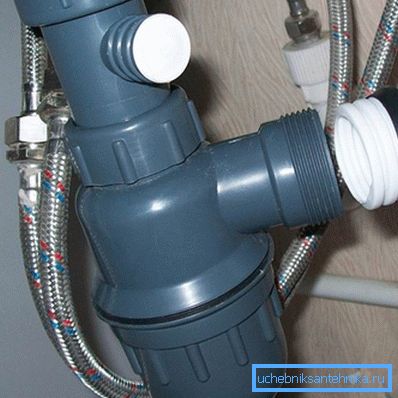
Note! Too tighten the nut, trying to ensure maximum tightness is not worth it, the plastic can just crack. It is better to just use a sealant.
- after that, the siphon for washing with overflow is connected to the sink through a plastic tube. The connection is made according to the same scheme - with the help of a cap nut and a gasket;
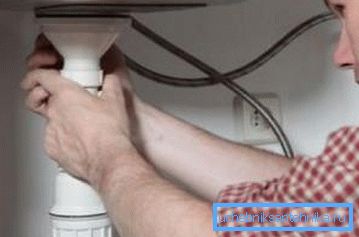
- The key difference from the conventional model is that an additional drain is connected directly under the sink to the drain pipe.
After installation, you need to make a test drain water, it will be enough just to pour into the sink 7-10 liters of water and observe the behavior of the compounds. If one drop of water seeps out, it is better to disassemble this connection in hot pursuit and correct the defect, if this is not done, then leakage is guaranteed in this place in the future.
Sometimes it becomes necessary to install a double-sink siphon with overflow, the procedure in this case remains almost unchanged. The main difference is that the siphon directs the flow directly from the two sinks, respectively, using 2 drain pipes.
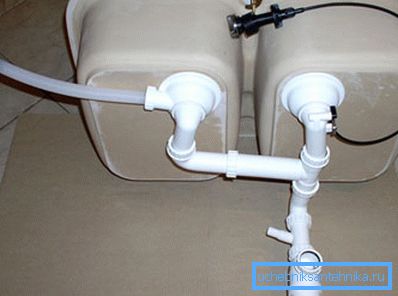
Most often in this case, a single overflow is enough. That is, an additional drain hole is arranged only in the sink in which water is drawn. In the second it is not necessary.
You need to understand that by installing a siphon for a sink with overflow, you will only receive a kind of “safety” against overflow of the sink, in case of siphon clogging you will not need an additional drain hole. Given the low cost of such an improvement of the classic design, the additional drain device looks justified.
findings
The additional drain device in the sinks is an extremely useful thing, thanks to this improvement in the usual siphon the flood in the kitchen is canceled. It is also important that this can be achieved without much complication of the design; all installation work can still be performed independently, without the help of a professional plumber.
The video in this article shows an example of installing a water seal with overflow.